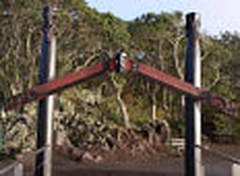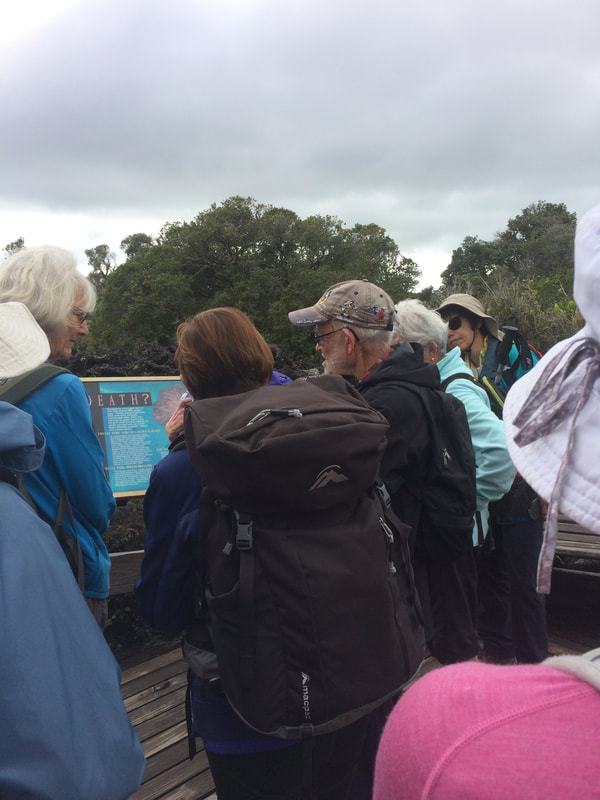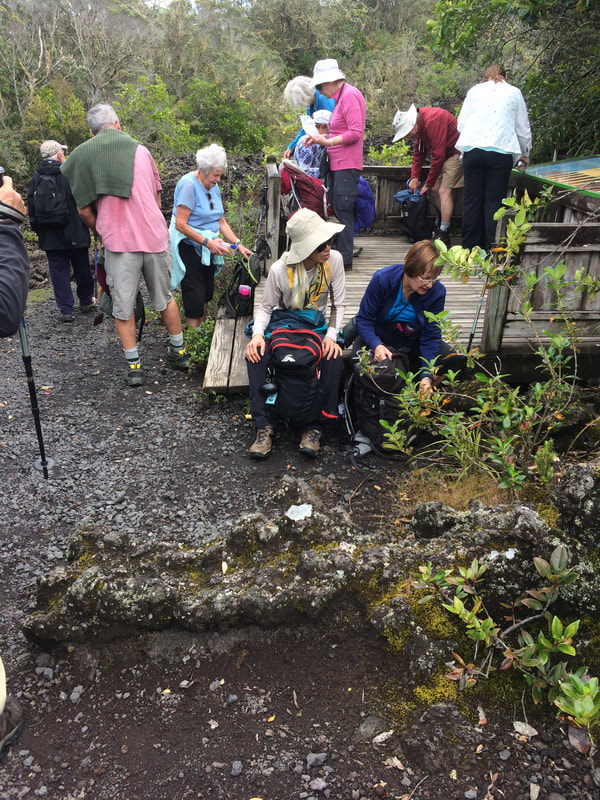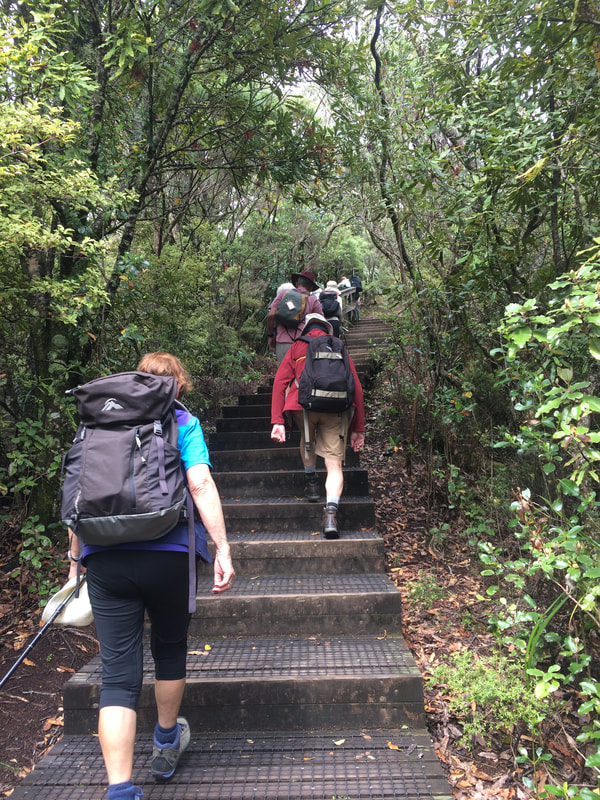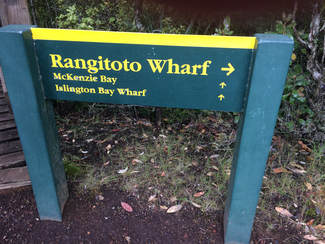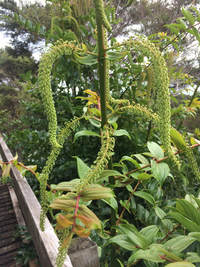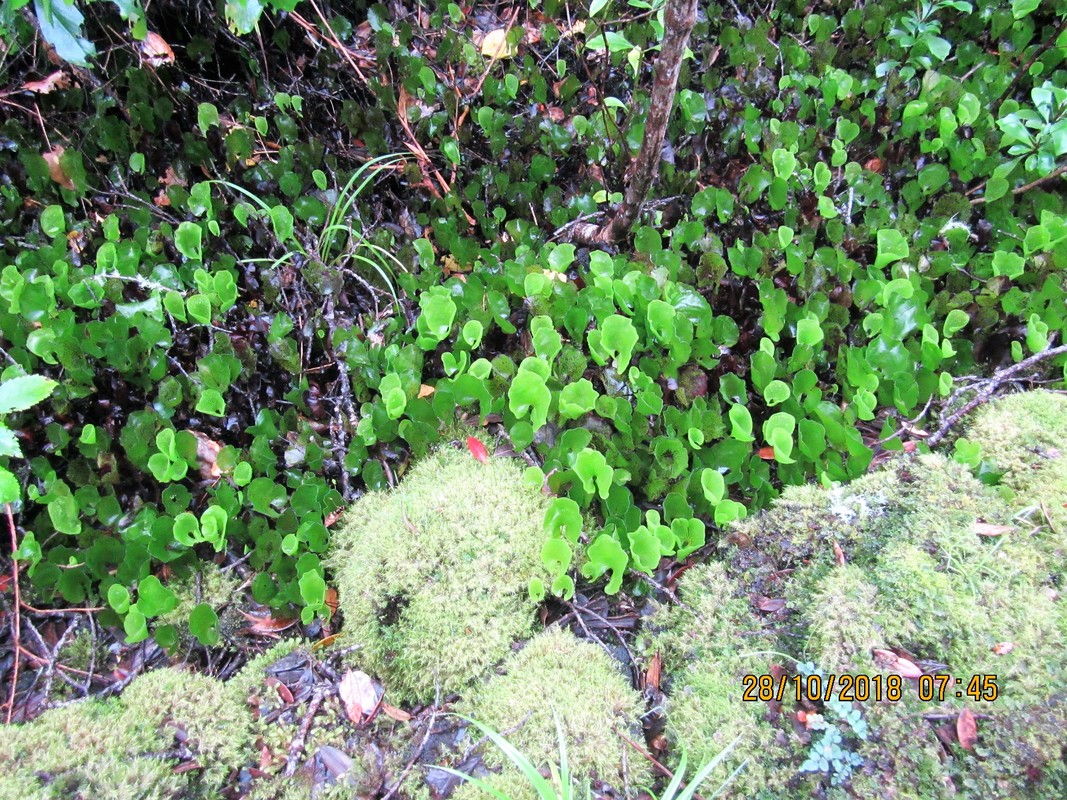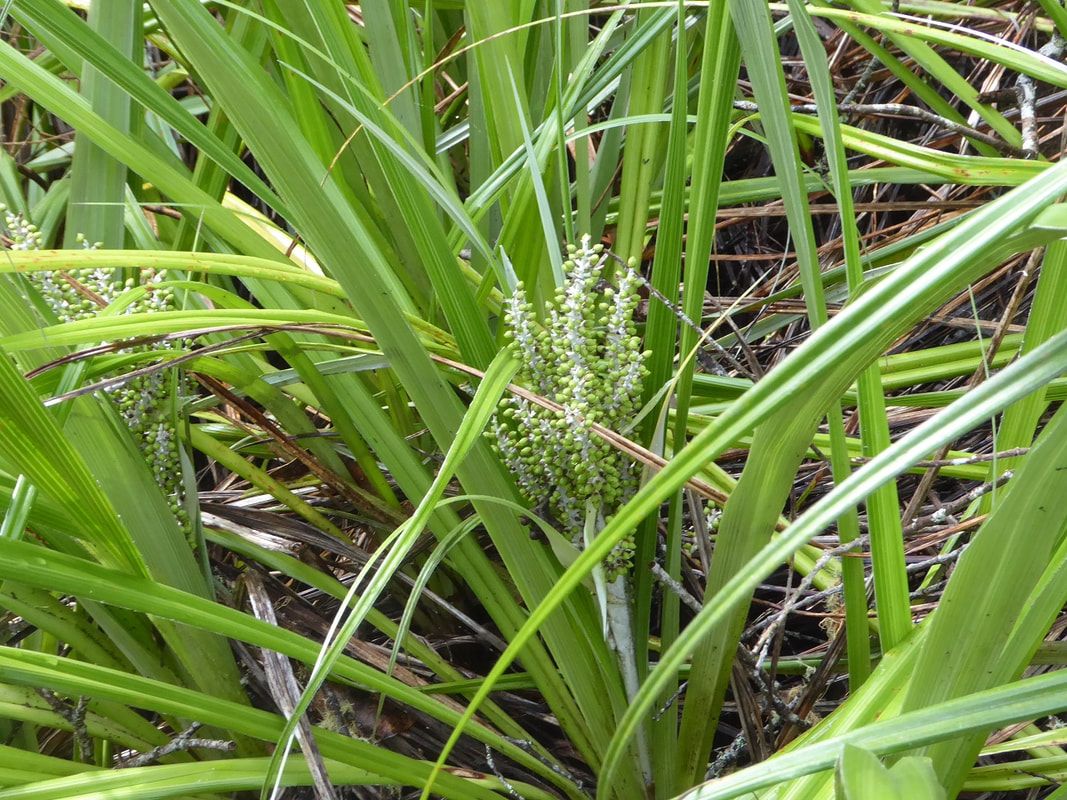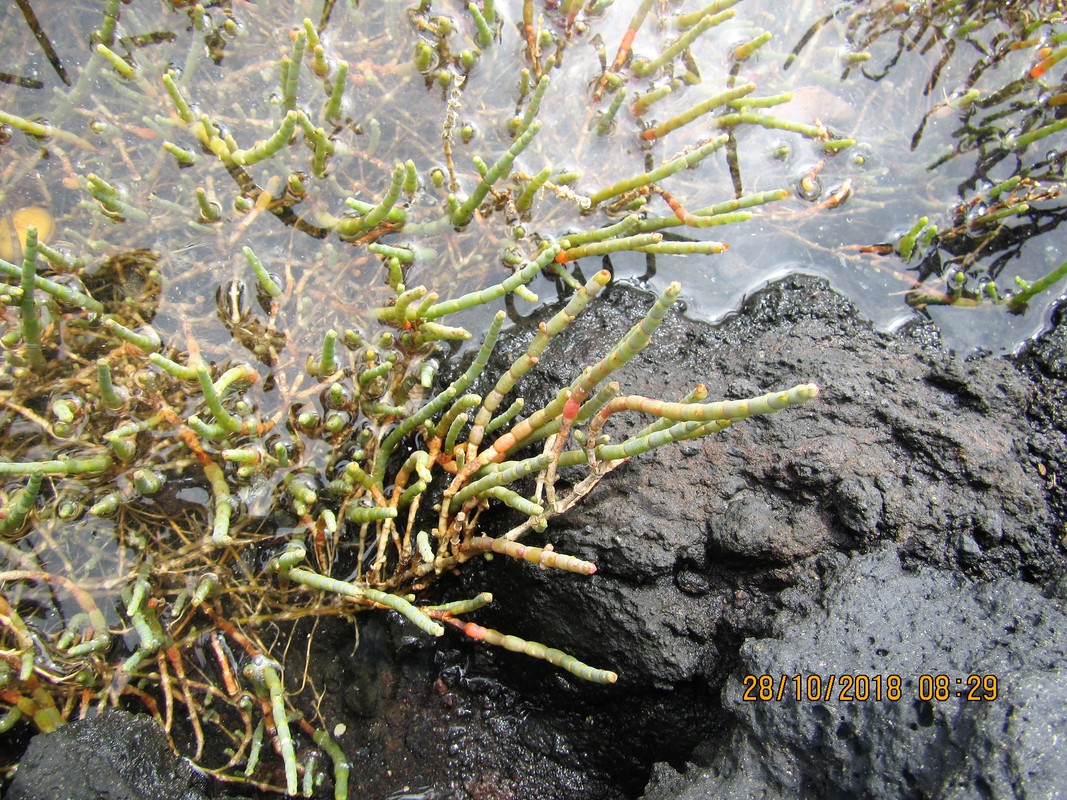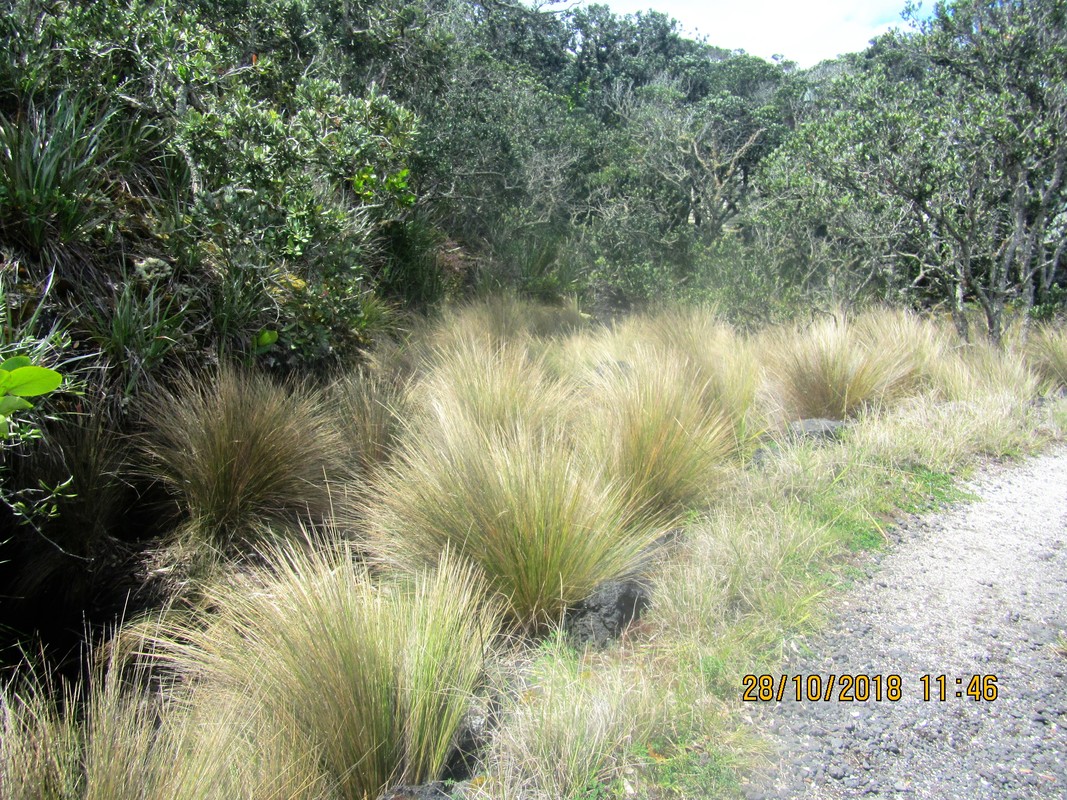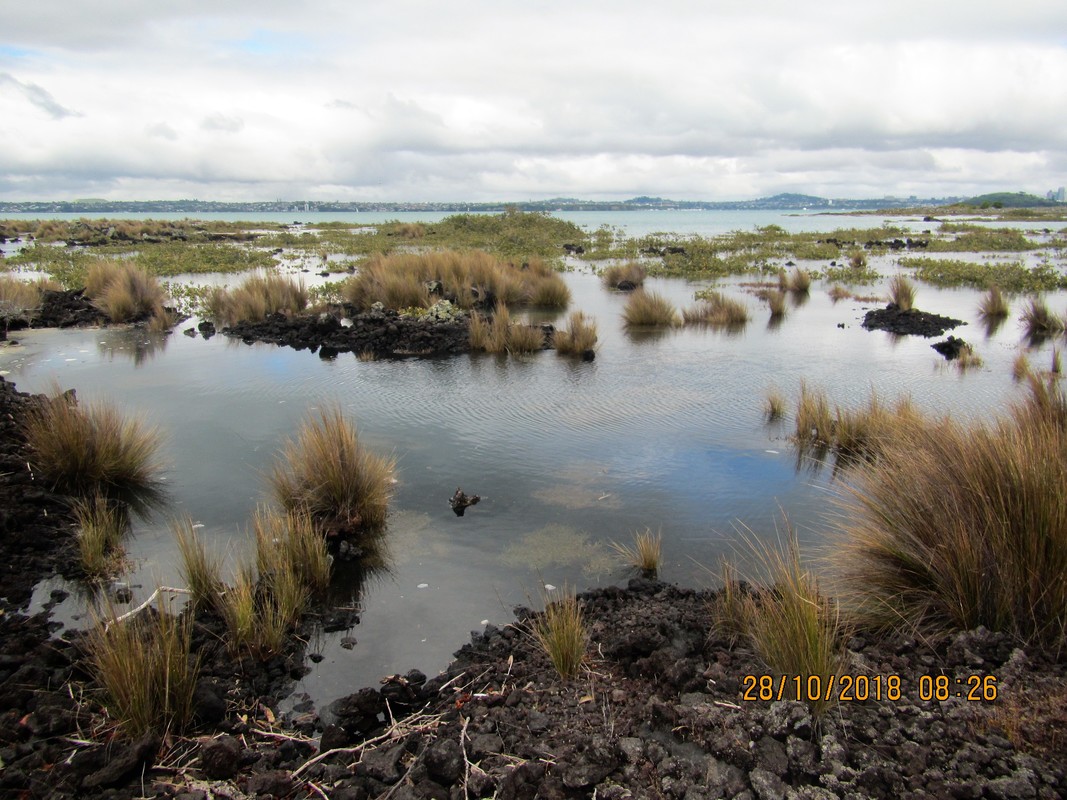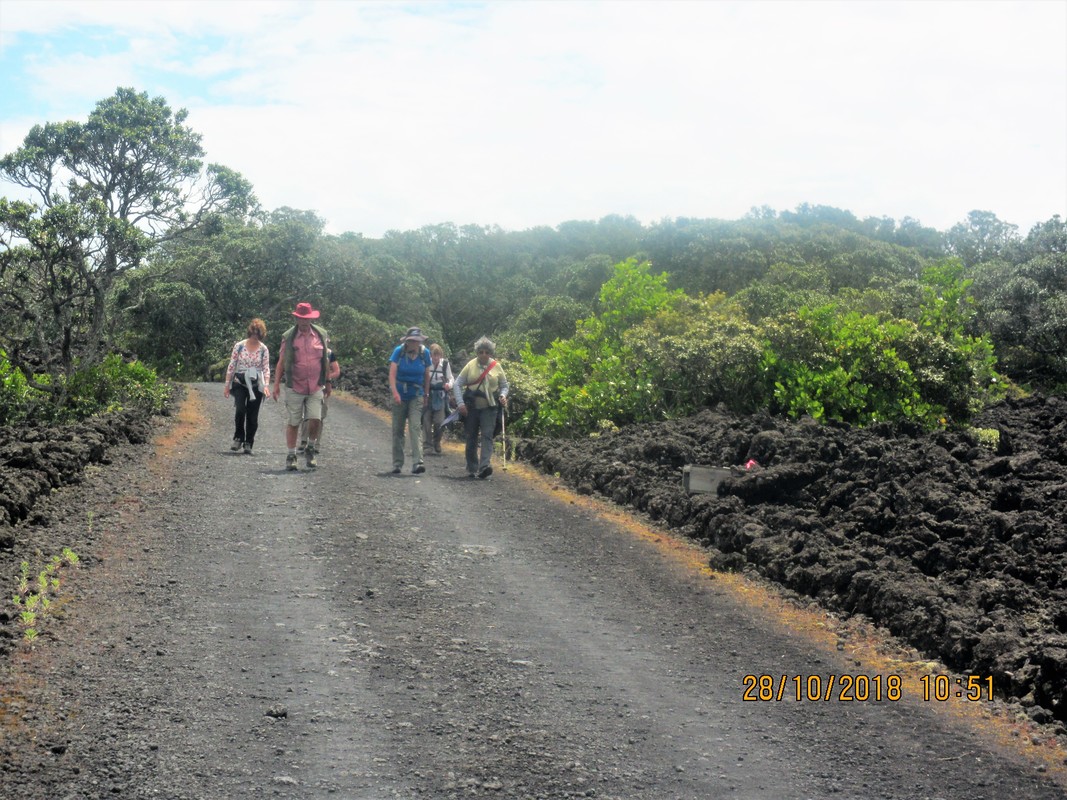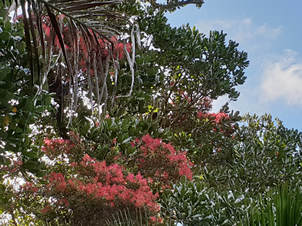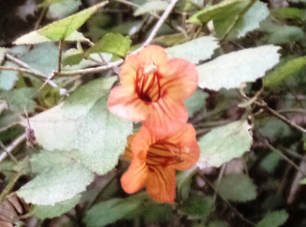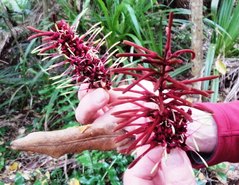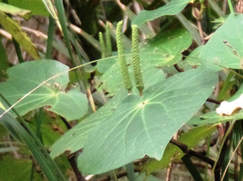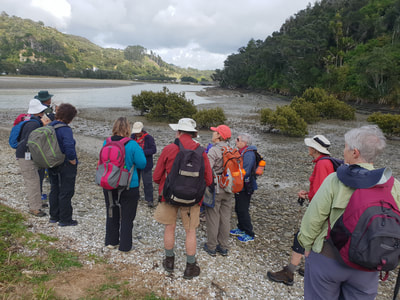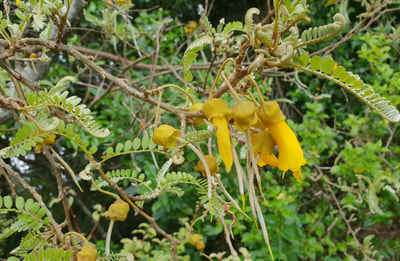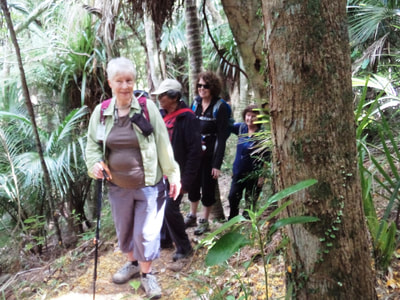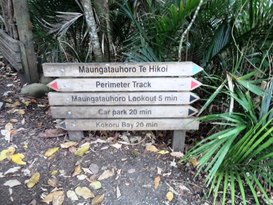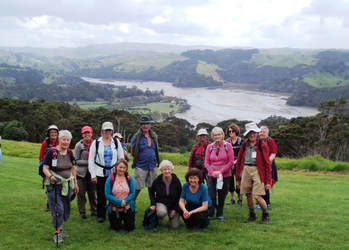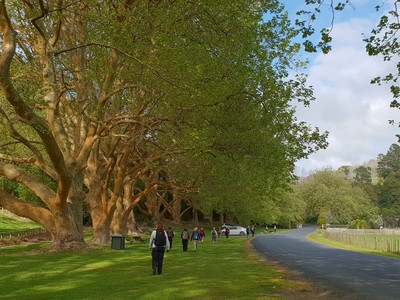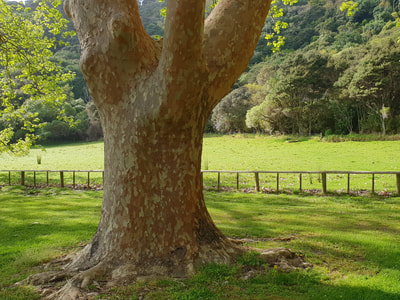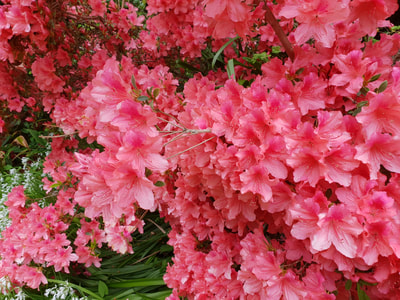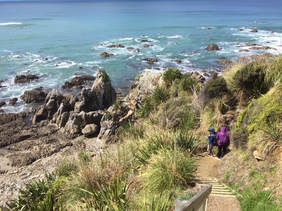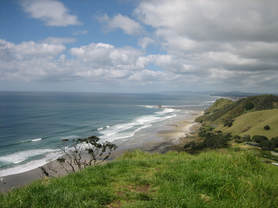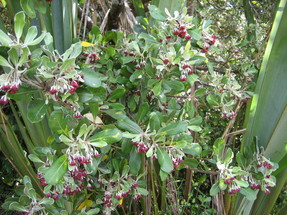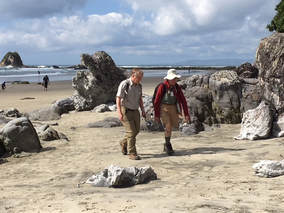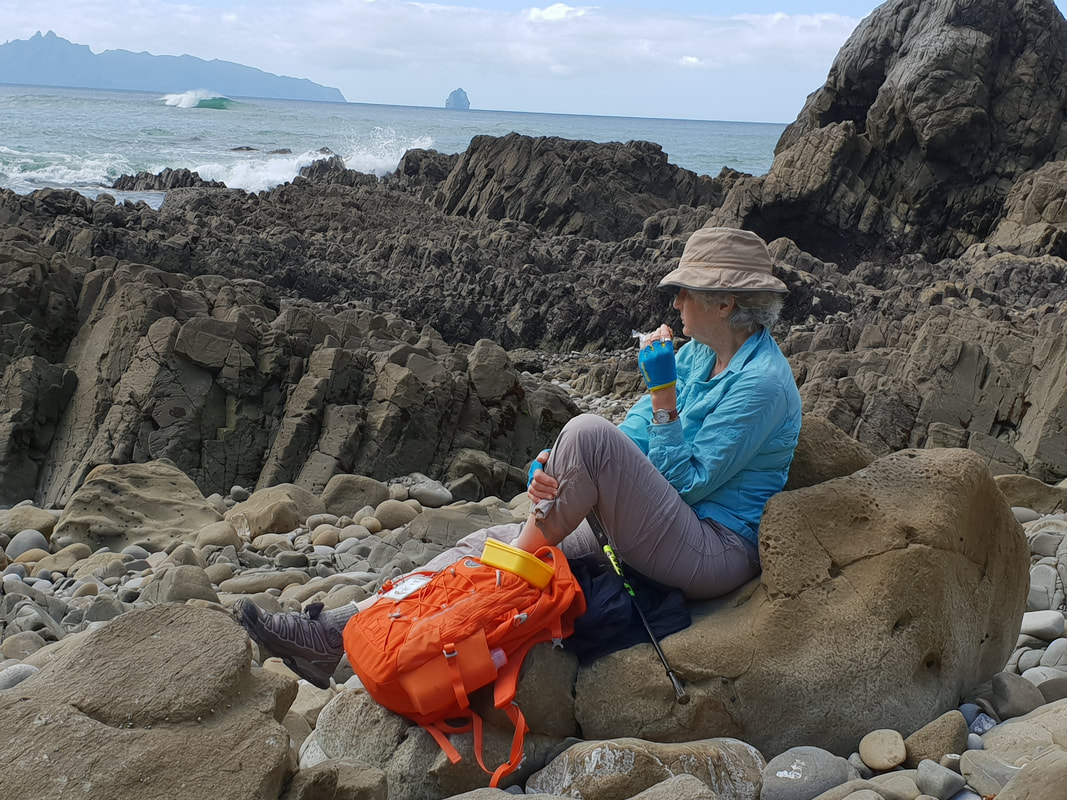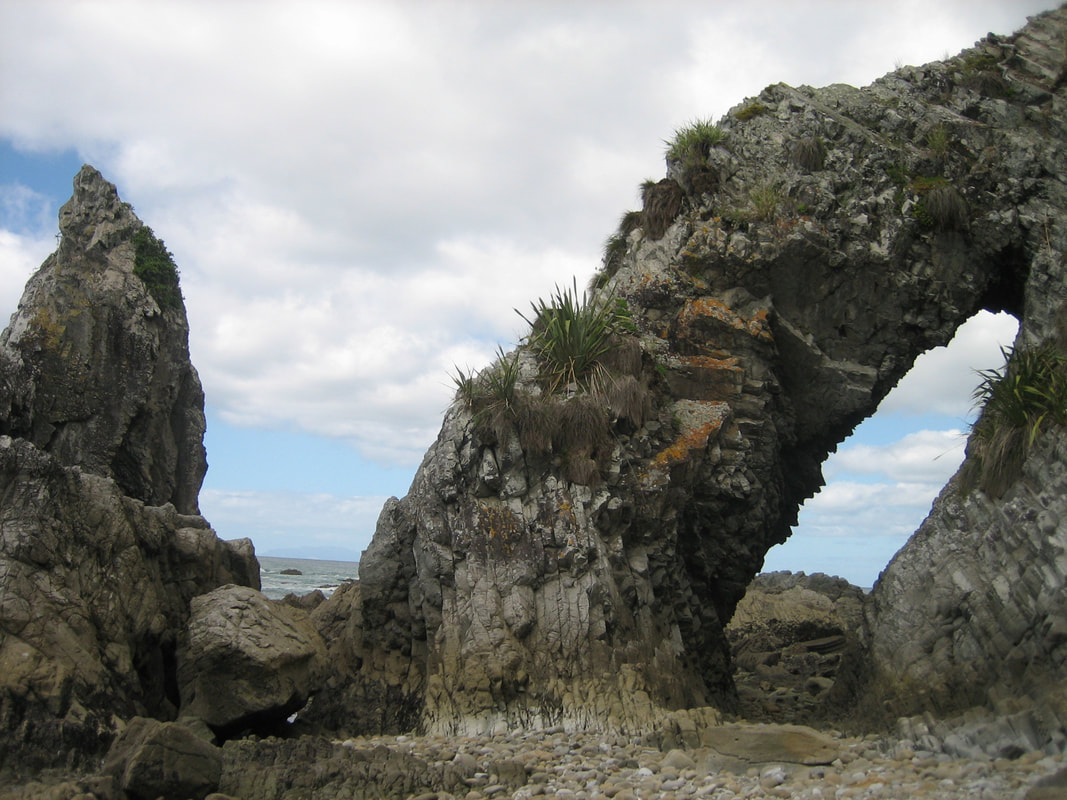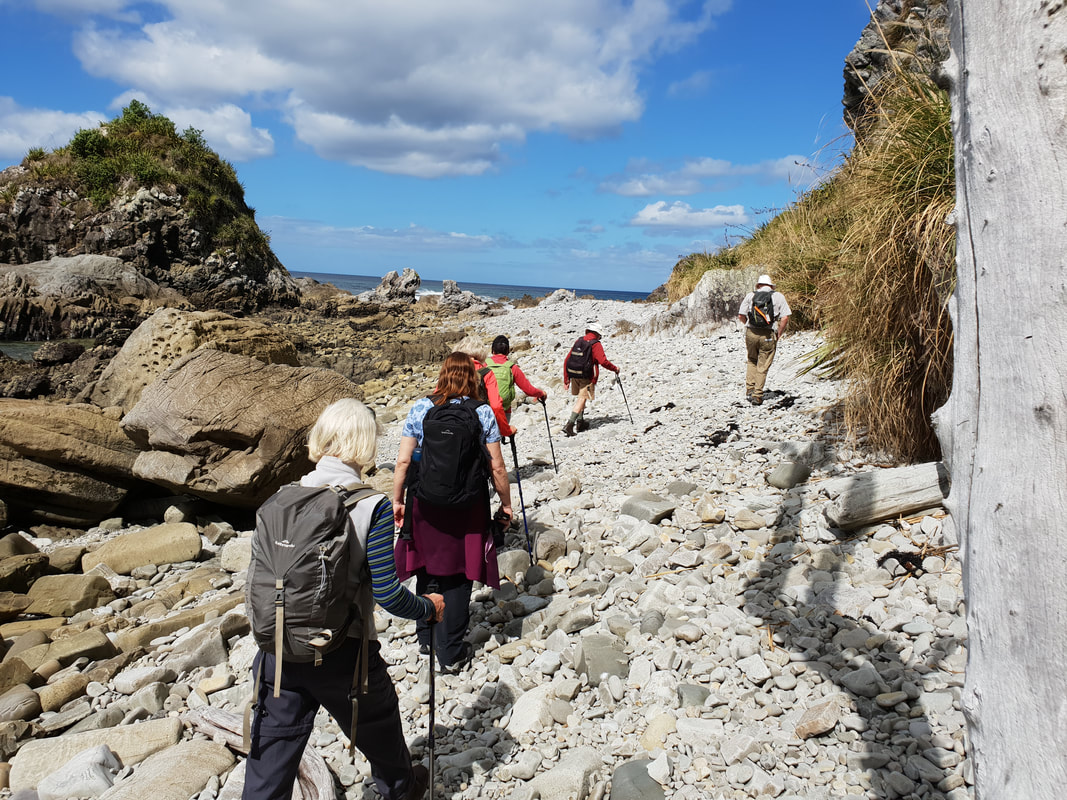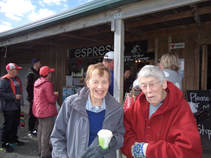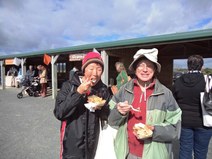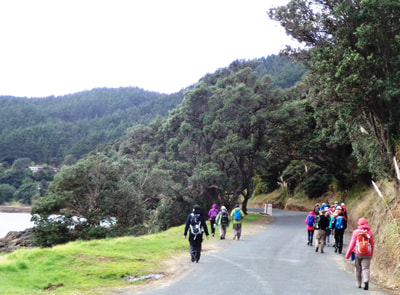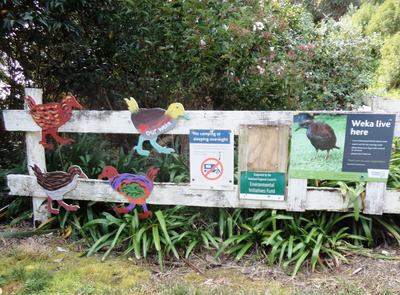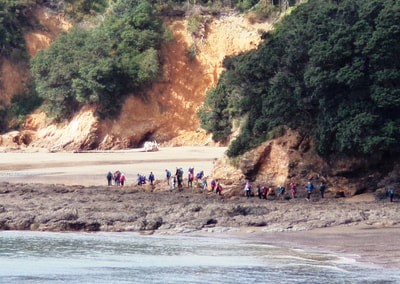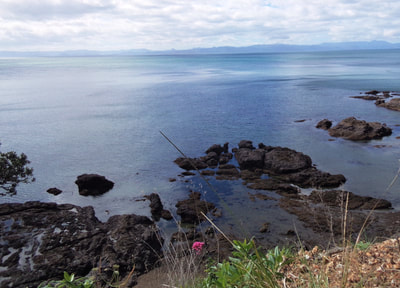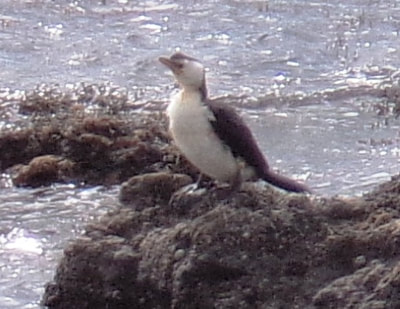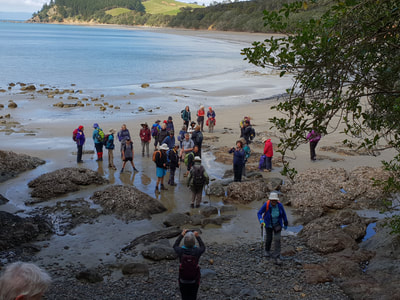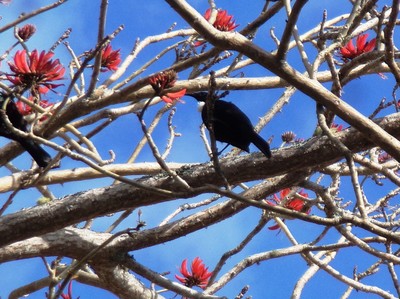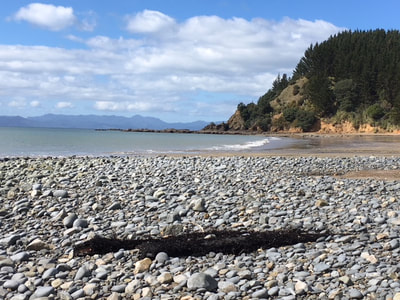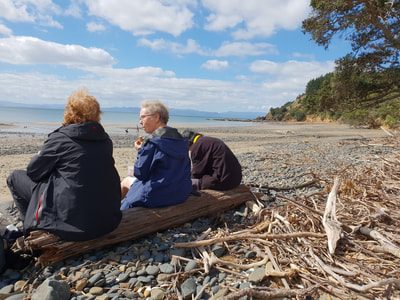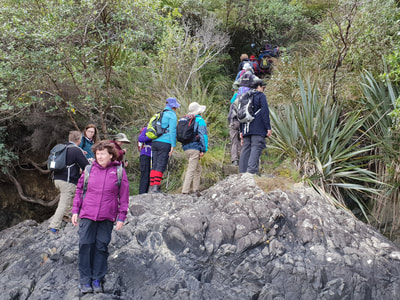Trip Reports: September - October 2018
October 28 - Rangitoto Island
Our trip today was to the extinct volcanic island Rangitoto, Auckland’s youngest and largest volcanic field which is believed to have emerged from the sea about 600 years ago. Nineteen walkers, well prepared for forecasted rain and compliant with the bio-security requirements to visit this island, boarded Fullers' ferry for the short 25-minute trip.
|
On our arrival we passed through the Gateway of Peretu (Te Waharoa O Peretu) which is situated at the end of the wharf. Named after Peretu an early Maori ancestor who had a parrot reserve on the island. Peretu had three fingers, this was not considered a deformity but a sign of his descent from a reptile god ancestor. Carvings on the posts of the gateway represent the Taratua (God of the Sea) and Tane Mahuta (God of the Forest), in the middle is a carving of a kaka (parrot).
|
"A" group was led by Fiona up the Main track, stopping to read the many information boards about the volcanic nature of the island on the way and to enjoy morning tea in the sunshine.
Arriving at the lookout they took time to enjoy the 360-degree views before descending via wooden stairs and boardwalks to the Summit Road. The walk down the Summit Road is a gentle descent which affords great views over the water and back to Auckland City. Tutu was prevalent on this part of the track.
Next, we followed the Coastal Road to the causeway. With the high tide and the sun shining on the aqua blue water, this area took on the surreal beauty which we paused to enjoy. On either side of the road, volcanic fields made up of mostly a’a lava (a basaltic lava that doesn't flow very quickly) can be seen with hardy regenerating plants growing in the crevices.
|
We then made a short detour toward the black back gull colony. Having read that the gulls would be laying eggs from mid-October to mid-November we were disappointed the track didn’t take us close enough to get a good look. Next time we will take binoculars. Refreshed after a roadside morning tea we continued on passed the Rangitoto Beacon (built in 1882, it currently flashes every 12 seconds) to McKenzie Bay where we met the "A" group and enjoyed a well-deserved rest and lunch on the beach whilst looking back to Auckland City. |
Both "A" and "B" groups then returned to the Rangitoto Wharf via the Coastal Track. A short diversion took us past a few of the thirty-five original baches still standing and, in some cases, empty sections with concrete steps leading to nowhere, and flowering exotic plants where baches once stood. Information boards reminded us of the families who were lucky enough to enjoy many happy holidays here in the past.
Finally, Fullers had turned on an extra ferry at 2.30 p.m., and with minutes to spare we clambered aboard. A tired but happy group returned to Auckland after enjoying some good exercise, interesting views, plants and sunshine.
Many thanks to:
Leaders: Fiona and Molly
Text: Molly
Photos: Praemi, Linda, Molly
Leaders: Fiona and Molly
Text: Molly
Photos: Praemi, Linda, Molly
October 7 - Wenderholm
Only 15 walkers today so, instead of using a bus, we carpooled and met in the parking lot at Wenderholm.
It was a lovely day and just the right temperature for walking.
It was a lovely day and just the right temperature for walking.
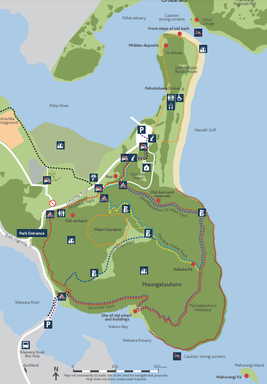
Wenderholm Regional Park sits neatly between the Puhoi and Waiwera Rivers.
We started along the Perimeter Track and were fortunate to see lots of carmine rata in flower. The comment was made that we had not seen so much flowering rata before so obviously a good season for it. We were also lucky enough to see gloxinia in flower although getting to the end of the season. Gloxinia is a New Zealand native and part of the African violet family.
Morning tea was at Kokoru Bay, sitting on the beach and looking across the water to the back of Waiwera. Quite a different perspective of it.
We then all headed up the challenging climb to the top of the cliff. Fortunately it was quite dry so no slipping and sliding. We took it slowly giving ourselves time to listen to the birds and to admire the trees - lovely old puriri with huge trunks full of moth holes.
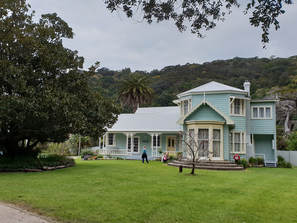 Couldrey House
Couldrey House
A diversion was made along the Couldrey House Track to the Puhoi Track to see the gorgeous views over the Puhoi Estuary and the surrounding farmland. It was then back along the Perimeter Track and down the large number of well formed steps to Couldrey House.
The lovely trees we saw certainly made the visit worthwhile. Many are historic and were gifted to the owner of Couldrey House (Robert Graham) by Sir George Grey. They include the old gnarly puriri trees, the gorgeous old plane trees with their beautifully coloured trunks, the Moreton Bay fig with the most ginormous trunk, the very interesting cork tree, the huge pohutukawas, the extremely large azalea in full flower, the rhodos and camelias. Certainly a day of variety.
Many thanks to:
Leaders: Anne and Shirley
Text: Anne
Photos: Sharleen and Sue
Leaders: Anne and Shirley
Text: Anne
Photos: Sharleen and Sue
September 23 - Mangawhai clifftops
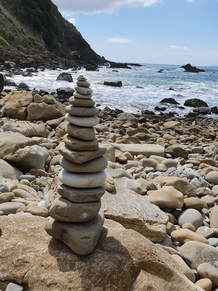 Someone was here before us!
Someone was here before us!
A lovely day was had by all on Sunday when we went up to Mangawhai Heads.
It's a interesting drive up from Auckland to the Heads and being high up in the bus we had a great vista of the surrounding farmland.
Our walk started off along the beach then up numerous steps to the look-out platform. It's amazing the different shades of blue and green of the sea and looking down the coast at the waves breaking onto the sandy beach was very pretty. The offshore islands were clearly visible - Hen and Chicken, Sail Island and Great Barrier.
Our walk took us along the cliff top past an abundance of NZ native trees, kahikatea, puriri, totara with their lovely bark, mahoe, plenty of kawakawa, taraire, rata, flowering ngaio and flowering karo and of course not to forget the fabulous pohutukawa, looking as though they were about to topple into the sea.
Our walk took us along the cliff top past an abundance of NZ native trees, kahikatea, puriri, totara with their lovely bark, mahoe, plenty of kawakawa, taraire, rata, flowering ngaio and flowering karo and of course not to forget the fabulous pohutukawa, looking as though they were about to topple into the sea.
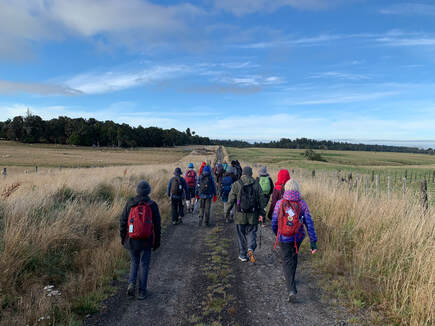 "Sea biscuit" - Fellaster zelandiae
"Sea biscuit" - Fellaster zelandiae
The walk is a loop walk at low tide only so it was down the numerous steps through the rock arch and across the rocks and smooth boulders to get back to the main beach. Quite a challenge over the rocks but very enjoyable.
The rock archway proved very popular with the photographers amongst us and all were fascinated to find a "sea biscuit" amongst the shells (actually a kind of sea urchin, a NZ species - Fellaster zelandiae) Thanks Praemi.
A big thank you to Don and to Anne for a great day out.
Text: Anne
Photos: Bev, Katherine, Sharleen
September 9 - Tawhitokino "Secret Beach"
Forty-two of us set off on a cool bright morning. First stop Clevedon Market with its interesting variety of stalls, and welcome hot drinks and tasty morsels.
Back on the bus, we proceeded through the rural landscape and along the scenic coast to the far end of Kawakawa Bay. Our walk began along the narrow winding road above the shore to Waiti Beach. From the beach we went over rocks around the headland to a sandy bay which is only accessible when the tide is out.
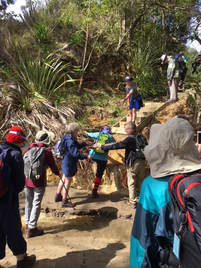 Washed-out steps
Washed-out steps
Towards the end of the bay, beside a stream under an old pohutukawa tree, we ascended the track over Papanui Hill. Both ends of the track had been damaged by storms, making access tricky, particularly at the start, where a few steps were missing, and a rope provided by John was helpful.
There were many steps on the track, passing through native bush, which included coprosma, flax, koromiko, mahoe, manuka and ponga. Climbing over the hill provided splendid views of the coast, and across to Ponui Island, with Waiheke Island and Coromandel in the background, and then the secluded and beautiful Tawhitokino “Secret Beach”.
We descended over rocks and walked along this long sandy beach that could only be reached on foot, or by sea. Towards the far end we stopped for lunch, either on the beach, or on the grassy slopes or tables at the campsite.
The greywacke rocks at both ends of the beach provided an interesting contrast from the sandstone cliffs, and overhanging pohutukawa. We found a variety of shells on the beach, and sedges and flax bordering the streams running onto the beach.
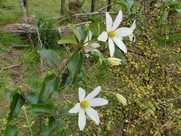 Clematis
Clematis
We returned the way we had come, discovering clematis in the bush as we descended from Papanui Hill, and kowhai along the roadside back to Kawakawa Bay.
Thanks to
Leaders: Anne and Vivien
Text: Vivien
Photos: Bev, Sharleen and Sue
Leaders: Anne and Vivien
Text: Vivien
Photos: Bev, Sharleen and Sue
